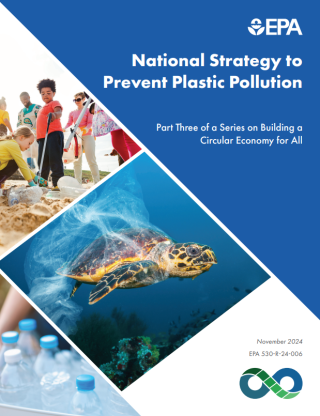National Strategy to Prevent Plastic Pollution
On this page:
- National Strategy to Prevent Plastic Pollution: Part Three of a Series on Building a Circular Economy for All
- Draft National Strategy to Prevent Plastic Pollution
National Strategy to Prevent Plastic Pollution: Part Three of a Series on Building a Circular Economy for All
The "National Strategy to Prevent Plastic Pollution: Part Three of a Series on Building a Circular Economy for All" provides an ambitious approach to reducing and recovering plastics and other materials, as well as preventing plastic pollution from harming human health and the environment.

For decades, EPA has worked to protect human health and the environment from air and water pollution and mismanagement of solid and hazardous waste created throughout the materials lifecycle. Congress recognized the need to take further action to address plastic pollution and passed the Save Our Seas 2.0 Act in December 2020. The Act directed EPA to develop a national strategy on plastic pollution. Together with EPA’s "National Recycling Strategy" and the "National Strategy for Reducing Food Loss and Waste and Recycling Organics," the "National Strategy to Prevent Plastic Pollution" presents opportunities for voluntary and regulatory actions by:
- Businesses.
- Academia.
- Industry.
- Nongovernmental organizations.
- Federal, Tribal, state, local, and territorial governments.
- Consumers.
Together, these U.S. entities could eliminate the release of plastic waste from land and sea-based sources into the environment by 2040. These opportunities consist of interventions across the entire plastics lifecycle to reduce the U.S. contribution of plastic pollution into the environment. The final strategy reflects input from many interested parties – including public feedback from almost 92,000 comment letters from federal, Tribal, territorial, state, and local governments; industry and trade organizations; community and national nongovernmental organizations; academia and private individuals.
The "National Strategy to Prevent Plastic Pollution" has six main objectives that address plastic pollution throughout the lifecycle of plastic products:
A. Reduce Pollution from Plastic Production.
B. Innovate Material and Product Design.
C. Decrease Waste Generation.
D. Improve Waste Management.
E. Improve Capture and Removal of Plastic Pollution.
F. Minimize Loadings The amount of pollutants being discharged or deposited into a waterbody. and Impacts to Waterways and the Ocean.
Each objective is followed by opportunities for action that support the United States’ shift to a circular approach to materials management, which is restorative or regenerative by design, enables resources to maintain their highest value for as long as possible, and aims to eliminate waste in the management of plastic products.
- National Strategy to Prevent Plastic Pollution (pdf) .
- Executive Summary.
- Webinar Slides for National Strategy to Prevent Plastic Pollution (pdf)
Draft National Strategy to Prevent Plastic Pollution
In April 2023, EPA published the "Draft National Strategy to Prevent Plastic Pollution" for public comment. EPA received almost 92,000 comment letters from industry and trade organizations, national and community-based NGOs, academia, government agencies (e.g., federal, Tribal, state, and local) and private individuals.
The comment period closed on July 31, 2023. You can visit the docket to view the draft strategy, executive summary, submitted comments, and other public comment information.
